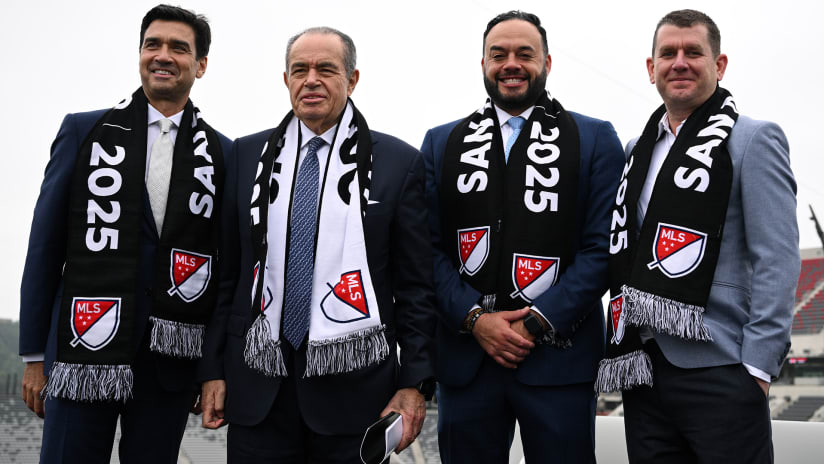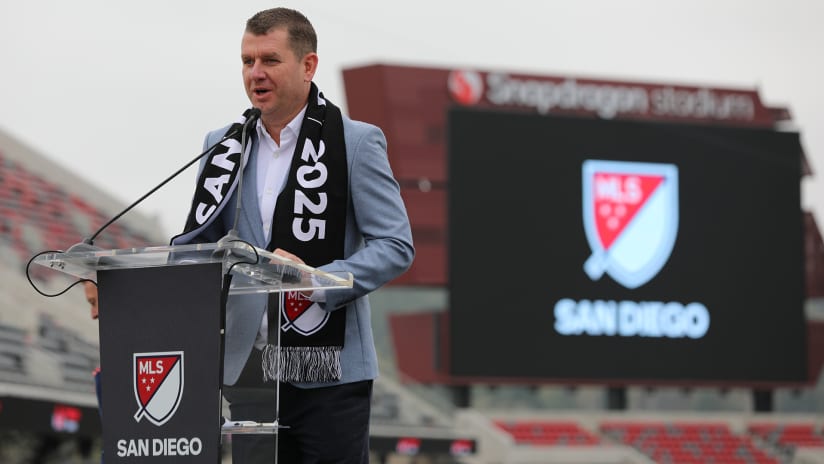SAN DIEGO – Back in 1999, when Tom Vernon founded the Right to Dream Academy in Ghana, it was a modest operation trying to impact a small corner of the soccer-playing world.
Fast forward nearly two-and-a-half decades and Right to Dream is coming to San Diego, providing the academy framework for Major League Soccer’s newest club that will begin play in 2025.
As MLS team No. 30 debuts at Snapdragon Stadium, their unique approach to youth development isn't just an add-on. It’s a central, defining feature.
“What we've found is the essence and the idea of Right to Dream appeals globally,” the former Manchester United scout told MLSsoccer.com before Thursday’s formal announcement. “So I think in a sport that's getting pulled in many directions, we reflect a lot of the original, pure values of what the game is about.
“I've been many places in the world where people would like Right to Dream to be there, but the combination of MLS and the combination of the potential in the youth in this city made it a natural spot for us.”
A new beginning
Those values are about providing promising players, regardless of socioeconomic background, the chance to better their lives through soccer. With sport as the conduit, they hone areas like character, work ethic and academic pursuits. Above all, Vernon said it’s about “doing the right thing by every kid to build a community” and setting them up for success beyond soccer. And yes, there’s the aspiration of turning professional.
But why San Diego? The answer, in part, is MLS’s latest expansion club is co-owned by Mohamed Mansour, whose London-based investment management firm Man Capital operates Right to Dream. The African-based academy also has several alumni on MLS rosters, a byproduct of them earning scholarships in the US academic system and matriculating through the SuperDraft.
The full answer pulls from the Greater San Diego area, which is already a hotbed for the sport and home to a vibrant, expansive youth circuit right along the Mexican border. FC Cincinnati striker Brandon Vazquez and FC Dallas winger Paul Arriola both grew up here, as did LAFC head coach Steve Cherundolo. Ditto for Columbus Crew legend Frankie Hejduk and LA Galaxy executive Jovan Kirovski. The list goes on and on.
With that history, Vernon is bullish on applying Right to Dream’s methodology and curriculum locally.
“The beauty is you can't define an American player because you have this global melting pot here,” said Vernon. “You've got a Latino, you've got an African-American, you've got an African diaspora, you've got a Caucasian interpretation of the game and it leads to so many different styles.
“In all our other markets where we have Right to Dream, there's a similar style to how our players play. But in the academy here, we envisage having players of all those backgrounds and styles, especially a Latino style we haven't done as much with. For us, that's going to be exciting and challenging for developing our coaches and having our players facing different challenges.”

Global footprint
Vernon was referencing Right to Dream’s growing global network, holding roots in Egypt and Denmark. In the latter country, they’ve molded top-flight side FC Nordsjælland into the youngest in Europe’s top leagues by blending Danish players with those brought in from Africa.
All the while, it’s important to note: San Diego will be an active two-way street in Right to Dream’s broader framework. Players overseas can come to MLS for a professional opportunity and those reared locally can head abroad.
“We see our clubs and our academies as a community,” Vernon said. “We see staff and players developing themselves and getting unique experiences within that community.
“We're prioritizing our academy here in the United States to develop players, but at the same time, players from our other academies and our other clubs will come and play here in the same way that players from here will go and play within other clubs and academies. Every individual will shape their own journey.”
Discussing the Right to Dream component of this new club, CEO Tom Penn said it’s “foundational, that's our club identity.” Well beyond the youth teams, there are immediate plans for this philosophy to mold San Diego’s earliest chapters.
“We'll hire a sporting director next,” Penn said. “It’s somebody who's going to integrate with the Right to Dream group and be the leader in San Diego. Then we'll work on players and coaches and how we're going to seed and build this team in combination with our sporting director.”
Mansour also addressed the on-field vision, suggesting a San Diego-infused roster awaits.
“We want to get local people from around the area and local players,” said Mansour. “We're going to start scouting for that.
“… We'll do it right. We want to put the base foundation correct. As a businessman, that's what we've always done. As someone who loves soccer, football – whatever you call it – it's in our blood.”

Planting roots
Embedding MLS’s newest team into San Diego’s preexisting youth infrastructure will prove challenging, partially explaining why Penn’s on-stage remarks included a call-out to “partner” with clubs in the region. The idea is to work together to fuel professional dreams, all to prioritize what’s best for the player.
Proven success can do a lot of the talking as well. There were seven Right to Dream academy graduates at the 2022 FIFA World Cup in Qatar, playing on the world’s biggest stage.
Understanding and adapting to the San Diego market will carry plenty of water, too.
“It starts with great talent identification and then a great development model,” said Vernon. “The vision is to put all that into place and also to have it shaped locally.
“We're not coming in with a foreign, cookie-cutter model we think can work anywhere. We've got some core elements of our development philosophy that won't change, but we're going to let this community and our partners here also shape the development environment. We believe that’s the best way to do things.”










